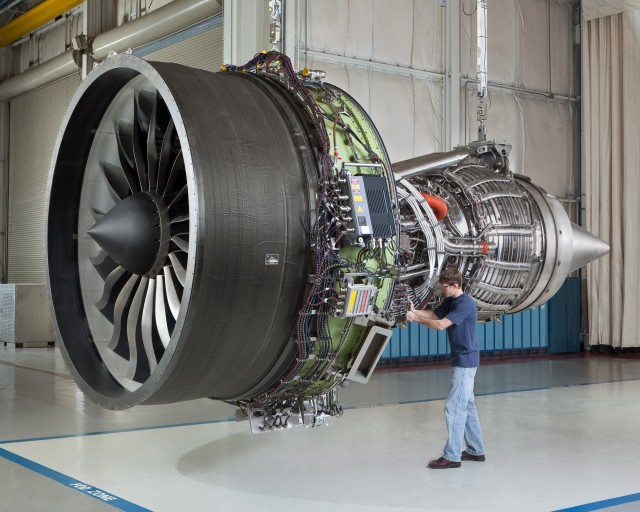This story was written by Steve Csonka, Director Environmental Strategy & ecomagination, GE Aviation for AirlineReporter.com.
As you may have inferred from Dale Carlson’s comments in an earlier blog post, many of us at GE Aviation are excited about our roles. I have been passionate about aviation since my teenage years when I took up general aviation flying ’“ learning my ’œstick and rudder’ skills in a Cessna 172 while living in the panhandle of West Virginia. I’˜ve spent 27 years in the commercial aviation industry with airlines and with GE Aviation, and in my current role, I am focused on improving the sustainability of aviation so future generations can experience the same passion.
The value of the aviation enterprise is interwoven into the fabric of our worldwide society ’“ providing fast, safe, and dependable transportation of people and goods. In fact, it is estimated that aviation is currently responsible for more than $2.2 trillion in global economic impact, or 3.5% of total worldwide gross domestic product.
However, we recognize that with our successes come additional challenges ’“noise around airports, local air quality emissions, greenhouse gases, and inflation of customer operating costs with rising fuel costs. The good news is that we continue to make progress in tackling these challenges using advanced technology. At GE, we call these efforts ecomagination ’“ striving to deliver operating and environmental performance with technology. At GE Aviation, our sustainability efforts align with industry goals and focus on three pillars of improvement: operations, infrastructure, and technology.
- For operational improvement, GE Aviation offers services that help customers make flight routes more efficient, schedule engine maintenance and ’œClearCore’ engine washing, and decide how much fuel to load on planes for peak operating performance. Every one of these procedures is critical for saving fuel and, in turn, costs and emissions.
- On the infrastructure side, GE Aviation is looking beyond making efficient engines and is working with customers and regulatory authorities to make efficient flight paths. Stay tuned for more on this from GE Aviation’s Steve Fulton!
- For the technology pillar, my colleague Dale explained in his guest post how GE Aviation researches and develops new, efficient technology. Whether it is the GEnx on the 787 and 747-8 (which just entered service), or CFM’s LEAP engine for the next generation single aisle transcontinental aircraft, GE’s technology enables our customers to burn less fuel, shrink the noise footprint around airports, and dramatically lower NOx emissions.
One innovation I’m excited to talk about is drop-in, renewable Jet fuel that, once commercialized, will enable the industry to achieve up to 80% reductions in net carbon emissions versus petroleum based fuel. The industry is also looking for alternative fuel sources that use a range of raw or waste materials that do not need to compete with food production or land use. So far, the industry has identified two pathways for the production of renewable Jet fuels, and is in the process of evaluating and validating at least five more.
Can you imagine a world where fuel comes from the waste stream and other biomass? I can. GE Aviation was one of the first companies, along with CFM, to test a biofuel-powered engine in flight. At last year’s Paris Air Show, GE Aviation showed an engine that was powered by 15 percent biofuel, and we will continue to discuss our biofuel-powered engines at this year’s Farnborough Air Show. Watch a video about our most recent renewable Jet fueled demonstration flights below, which, along with several other commercial flights, flew into Rio de Janeiro during the recent Rio+20 activities in June:
With all these innovations in operations, infrastructure and aircraft technology (including biofuels), I believe we have ample opportunity and reason to be passionate about the future of aviation. Stop by GE Aviation’s exhibit at the Farnborough Air Show this week to explore more of our sustainable tech: Booth #7, Hall 4.

These engines have come a long way since the days of the 707/DC-8/880/990.
A guest post OR rather a slick pr job by GE?
Both. I mean, when GE reaches out and asks if they might write a story about themselves, I don’t expect that they are going to write something negative.
David
I can understand that David. However, you loose some journalistic credibility when you give GE or any other corporation a free run on you blog. It’s different if you are reviewing their product, here, it just seems as if you are endorsing it. Like I said, you loose credibility and just appear to be a tool for them. BTW, I nothing against GE, I just think independence is a better road for the online blogs…….
I am aware of how it can be taken. And not like I wouldn’t allow them to post something I didn’t approve. I think I have enough mixture of content, but people know I am not a push over. If GE does something bad or something I do not agree with, I will be the first to call them out on it.
Just like with anything in the media, you have to take it with a grain of salt. At least I am making it very clear this was written by GE. So many times I see other journalists will write almost directly off a press release (not that I haven’t been guilty of that from time to time), but it is not noted that it is almost all the company’s word.
David